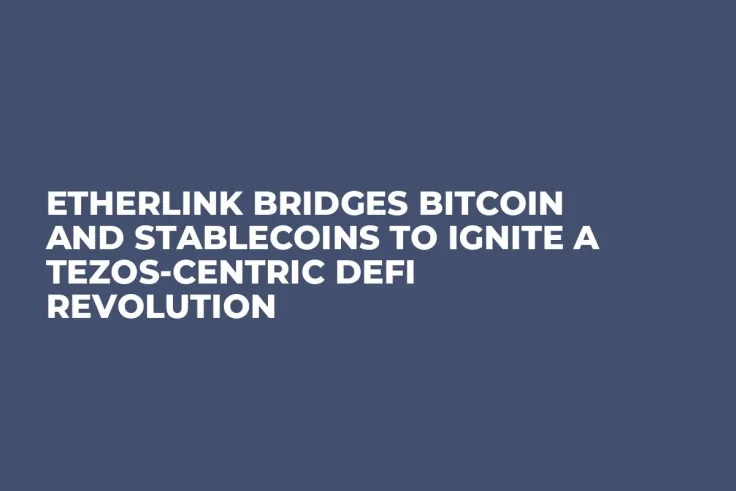
Disclaimer: The opinions expressed by our writers are their own and do not represent the views of U.Today. The financial and market information provided on U.Today is intended for informational purposes only. U.Today is not liable for any financial losses incurred while trading cryptocurrencies. Conduct your own research by contacting financial experts before making any investment decisions. We believe that all content is accurate as of the date of publication, but certain offers mentioned may no longer be available.
The past year or two have seen Etherlink (an EVM compatible L2) catalyze a major growth spurt across the Tezos ecosystem; thanks, in large part, to its inheritance of the latter’s security and governance framework alongside several Ethereum-like development tools.
Most recently, Etherlink announced a series of collaborations to help spur DeFi activity on Tezos, with one of the most important ones being its partnership with Bitcoin capital markets provider Lombard Finance. To elaborate, the firm deployed its flagship offering (a liquid staking token called ‘$LBTC’) atop the network, enabling holders to maintain their Bitcoin exposure while earning staking rewards through BTC staking protocol Babylon.
The setup has already gained massive traction across many networks, as nearly $2 billion worth of LBTC has entered circulation across Ethereum, Sui, Base, BNB Chain and more. Moreover, 70% of this supply has actively been deployed for DeFi use (on platforms like Aave and Morpho) making LBTC the primary Bitcoin asset on Tezos.
In a recent interview, Anthony Hayot, head of DeFi Adoption for Nomadic Labs, noted that LBTC stood out to him and his team for its “ideal” characteristics (such as liquidity, ease of use, etc) with Tezos Foundation executive director Jean-Frédéric Mognetti echoing d a similar sentiment, stating:
“The Tezos ecosystem has always prioritized innovation, and bringing Bitcoin's liquid staked Bitcoin to Etherlink reflects that foundational vision. This integration will provide BTC holders with new and exciting opportunities in DeFi."
Supercharging stablecoin liquidity on Etherlink
Hot on the heels of its Bitcoin bridging activities, Etherlink scored another major win recently by teaming up with Curve Finance, one of the world’s most popular stablecoin exchanges. Long a staple of the Ethereum DeFi landscape, Curve offers an automated market maker focused on stable-value assets (like USDT, USDC, or wrapped BTC), allowing trades with minimal slippage and fees often under 0.1%.
In practical terms this means Tezos users can tap into liquidity pools comparable to Ethereum’s, but with a much higher transaction throughput and negligible fees. Not only that, Curve’s integration is also intertwined with Etherlink’s incentive programs, with the protocol set to participate in Apple Farm Season 2, a loyalty and rewards initiative offering over $3 million in incentives to boost user engagement.
LBTC is slated to be included in the initiative as well, allowing Bitcoin holders on Etherlink to earn extra yields seamlessly.
Lastly, it bears mentioning that to add institutional rails/support for real world assets (RWAs), Etherlink has teamed up with Hex Trust (a regulated digital-asset custodian), adding custody for tokenized uranium xU3O8. As a result, institutions can own the precious metal via a licensed custodian while still accessing Etherlink’s on-chain rails, something that has historically been impossible.
A convergence of ecosystems strung together by Etherlink’s vision
The aforementioned partnerships have not been isolated events, but reflective of Etherlink’s broader strategy to offer its clients the best of both world's, i.e. Tezos’s secure, energy-efficient proof-of-stake backbone, and the flexibility/developer-friendly environment of Ethereum’s extensive tooling.
In fact, developers who might balk at the idea of learning Tezos’s native smart contract languages (like Michelson) can deploy Solidity-based contracts on Etherlink using familiar tools like MetaMask and Hardhat.
This allows Etherlink to “speak the same language” as Ethereum and shorten any learning curves substantially, something that has proven to be a powerful draw. In fact, just a couple of months ago, prominent DEX aggregator Oku launched its Uniswap v3-like trading platform on the network.
Around the same time, crypto custody platform Midas too introduced yield-bearing tokenized assets (mBASIS, mTBILL and others) into Etherlink's nascent DeFi market, diversifying investment options further for users. Lastly, at the beginning of the year, the project integrated with Jumper Exchange, a bridge connecting over 50 different blockchains and L2s (from Arbitrum to Base).
The impact of this flurry has already become evident as Etherlink’s total value locked (TVL) recently hit an all-time peak of roughly $47.7 million, with about $88 million in assets flowing through its contracts.
The road ahead is paved with digital gold
All of this momentum seems to be feeding into a clear vision, one where applications from multiple networks are converging under Tezos’ secure umbrella. By anchoring an Ethereum-grade DeFi experience to Tezos’s reliability, Etherlink stands to give the ecosystem a much-needed boost in attracting liquidity and talent, especially given its permissionless, non-custodial design (where anyone can run a node or challenge the rollup’s commitments). Interesting times ahead, to say the least!
 Dan Burgin
Dan Burgin Vladislav Sopov
Vladislav Sopov U.Today Editorial Team
U.Today Editorial Team